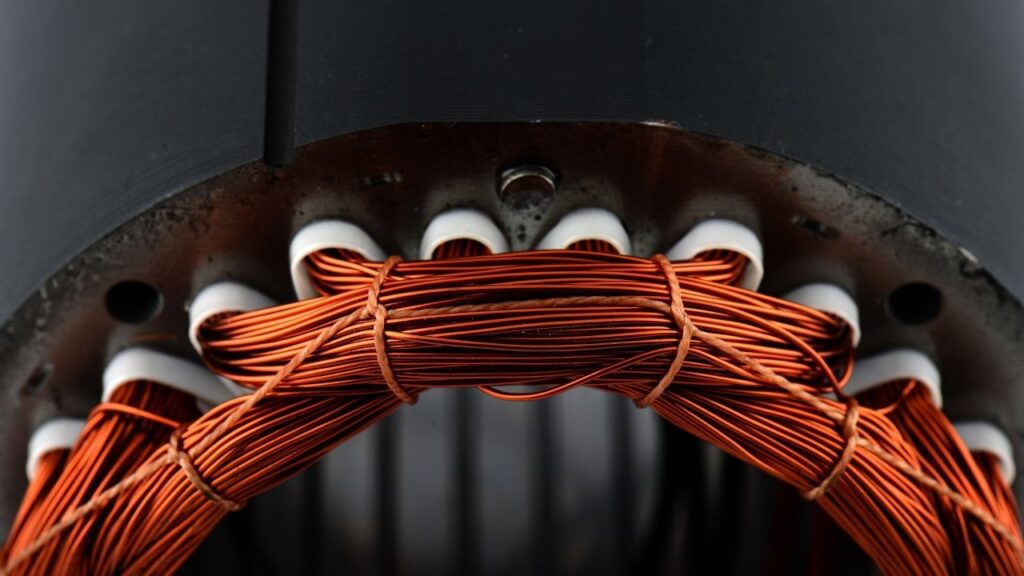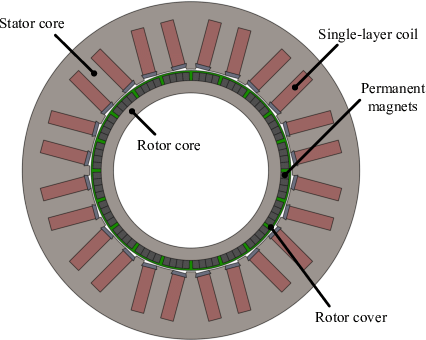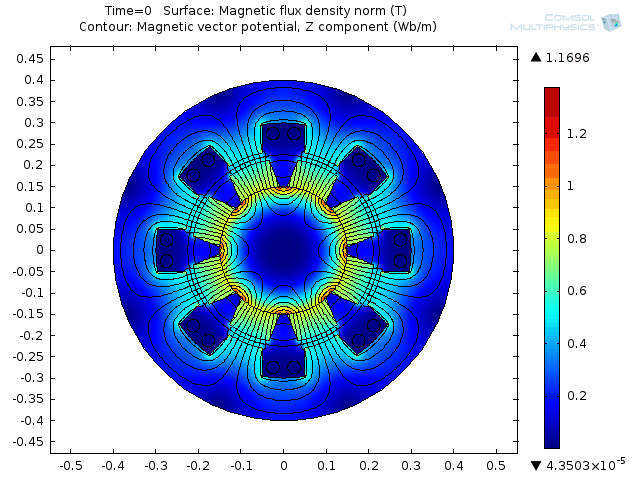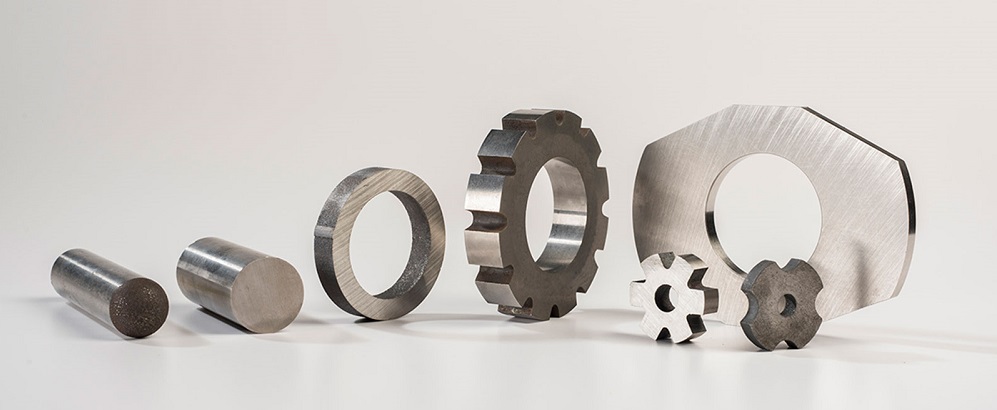
1. Structural design of permanent magnet generator
1.1 Magnetic circuit structure and design calculation
The biggest difference between a permanent magnet generator and an excitation generator is that its excitation magnetic field is generated by permanent magnets. Permanent magnets are both a magnetic source and an integral part of a magnetic circuit in a motor. The magnetic properties of permanent magnets are not only related to the manufacturing process of the manufacturer but also related to the shape and size of the permanent magnets, the capacity of the magnetizer, and the magnetization method. The specific performance data are highly discrete. Moreover, the magnetic flux and magnetomotive force that the permanent magnet can provide in the motor also vary with the material properties, size, and operating status of the rest of the magnetic circuit.
In addition, the permanent magnet generator has a variety of magnetic circuit structures, the leakage magnetic circuit is very complex, and the leakage flux accounts for a large proportion, the ferromagnetic material part is relatively easy to saturate, and the magnetic permeability is nonlinear. All of these increase the complexity of the electromagnetic calculation of the permanent magnet generator, making the accuracy of the calculation result lower than that of the electric excitation generator. Therefore, it is necessary to establish a new design concept, re-analyze and improve the magnetic circuit structure and control system; must apply modern design methods, study new analysis and calculation methods to improve the accuracy of design calculations; must study the use of advanced testing methods and manufacturing craft.

1.2 Control issues
After the permanent magnet generator is made, it can maintain its magnetic field without external energy, but it also makes it extremely difficult to adjust and control its magnetic field from the outside. These limit the application range of permanent magnet generators. However, with the rapid development of the control technology of power electronic devices, the permanent magnet generator does not need magnetic field control in the application, but only controls the output of the motor. The design requires the combination of three new technologies of NdFeB material, power electronic devices, and microcomputer control so that the permanent magnet generator can operate under brand-new working conditions.
1.3 Irreversible demagnetization problem
If the design and use are improper, the permanent magnet generator will be under the action of the armature reaction generated by the impact current when the temperature is too high (NdFeB permanent magnet) or too low (ferrite permanent magnet), or under severe mechanical vibration. Sometimes irreversible demagnetization may occur, which will reduce the performance of the motor and even make it unusable. Therefore, it is necessary to research and develop methods and devices for checking the thermal stability of permanent magnet materials suitable for motor manufacturers, and to analyze the anti-demagnetization ability of various structural forms, so that corresponding measures can be taken during design and manufacture to ensure permanent magnet generators do not lose their magnetism.
1.4 Cost issues
Since the current price of rare earth permanent magnet materials is relatively expensive, the cost of rare earth permanent magnet generators is generally higher than that of electric excitation generators, but this cost will be better compensated by the high performance and operation of the motor. In the future design, performance, and price comparisons will be carried out according to specific usage occasions and requirements, and structural innovation and design optimization will be carried out to reduce manufacturing costs. It is undeniable that the cost price of the product under development is slightly higher than that of the current general-purpose generator, but we believe that with the further perfection of the product, the cost problem will be well resolved.
2. Advantages of permanent magnet generator

2.1 Simple structure and high reliability
The permanent magnet generator eliminates the excitation winding, carbon brush and slip ring structure of the excitation generator, and the whole machine has a simple structure, which avoids failures such as easy burnout and disconnection of the excitation winding of the excitation generator, easy wear and tear of carbon brushes and slip rings, etc., and the reliability is greatly improved.
2.2 Small size, lightweight, high specific power
The adoption of the permanent magnet rotor structure makes the internal structure design of the generator very compact, and the volume and weight are greatly reduced. The simplification of the structure of the permanent magnet rotor also reduces the moment of inertia of the rotor, increases the practical speed, and achieves a very high specific power (that is, the ratio of power to volume).
2.3 Good power generation performance at medium and low speeds
In the case of the same power level, at idle speed, the output power of the permanent magnet generator is twice that of the excitation generator, that is to say, the excitation generator of the actual power level of the permanent magnet generator.
2.4 Can significantly prolong battery life and reduce battery maintenance work
The main reason is that the permanent magnet generator adopts a switch-type rectification and voltage stabilization method, which has high voltage regulation accuracy and a good charging effect. It avoids the shortening of battery life caused by over-current charging. The open-type rectification output of the permanent magnet generator uses small current pulses to charge the battery, and the charging effect is better with the same charging current, thereby prolonging the service life of the battery.
2.5 High efficiency
The permanent magnet generator is an energy-saving product. The permanent magnet rotor structure eliminates the excitation power required to generate the rotor magnetic field and the mechanical loss of friction between carbon brushes and slip rings, which greatly improves the efficiency of the permanent magnet generator. The average efficiency of ordinary excitation generators is only 45% to 55% in the speed range between 1500 rpm and 6000 rpm, while that of permanent magnet generators can be as high as 75% to 80%.
2.6 Using a self-starting voltage regulator
No need for an external excitation power supply. The generator generates electricity as long as it spins. When the battery is damaged, the car charging system can still work normally as long as the engine is running.
2.7 Especially suitable for working in humid or dusty harsh environments
2.8 No radio interference
The permanent magnet generator has no carbon brush and no-slip ring structure, which eliminates the radio interference caused by the friction between the carbon brush and the slip ring; also reduces the requirement of the generator for the ambient temperature.
3. Comparison of structural characteristics
3.1 Permanent magnet generator
The permanent magnet generator has a simple structure, a large rotor magnetic field, no excitation winding, no carbon brush, no slip ring, large air gap, no contact, and the only worn part of the whole machine is the bearing. The reliability of the product is improved, no external regulator is needed, and the distance between the magnetizer materials is optimized to reduce magnetic flux leakage so that the generator has good idle speed performance and sufficient output circuit.
Excitation generator:
The excitation generator has poor power generation performance at idling speed, and the battery is easily discharged; the efficiency of the generator is only 40%-50% in the range of 1500-6000 rpm, and the efficiency is low. Because the rotor has an excitation coil, the temperature of the whole machine rises; Excitation generators are also prone to problems such as carbon brushes and slip ring damage.
3.2 Volume temperature rise comparison
The permanent magnet type is simpler in structure than the excitation type generator, smaller in size, lighter in weight, superior in performance, and has sufficient power generation at low speeds.
4. The charm of rare earth NdFeB

“The Crown of Rare Earth” – NdFeB, a unique rare material, will become the darling of the industrial revolution in the 21st century because of its powerful magnetic carrying function. And the motor industrial revolution triggered by it has become the high attention of motor experts and automobile experts all over the world. According to the prediction of industry experts, the motor in the 21st century will be a world of permanent magnets.
As a country of rare earth, China’s reserves account for 80% of the world’s total, but the utilization and development of rare earth are not ideal. At present, we have found a breakthrough in the deep development and utilization of rare earth in wind power projects.